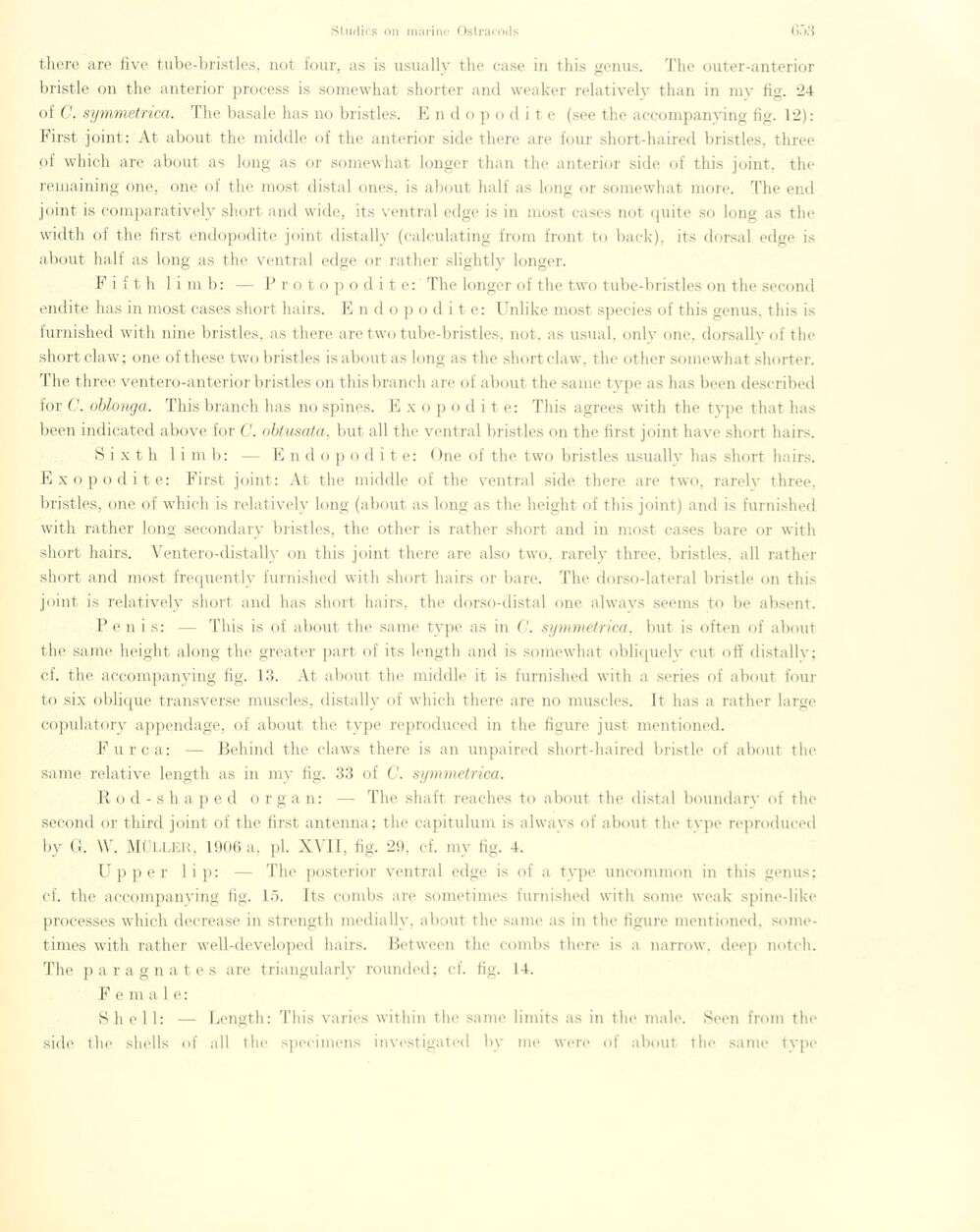
Full resolution (JPEG) - On this page / på denna sida - Sidor ...

<< prev. page << föreg. sida << >> nästa sida >> next page >>
Below is the raw OCR text
from the above scanned image.
Do you see an error? Proofread the page now!
Här nedan syns maskintolkade texten från faksimilbilden ovan.
Ser du något fel? Korrekturläs sidan nu!
This page has never been proofread. / Denna sida har aldrig korrekturlästs.
tliere are five tube-bristles, not four, as is usually the case in this genus. The outer-anterior
bristle on the anterior process is somewhat shorter and weaker relativelv than in mv fig. 24
of C. symmetrica. The basale has no bristles. E n d o p o dite (see the accompanving fig. 12):
First joint: At about the middle of the anterior side there are four short-haired bristles, three
pf which are about as long as or somewhat longer than the anterior side of this joint, the
remaining one, one of the most distal ones, is about half as long or somewhat more. The end
joint is comparatively short and wide, its ventral edge is in most cases not quite so long as the
width of the first endopodite joint distally (calculating from front to back), its dorsal edge is
about half as long as the ventral edge or rather slightly longer.
F i f t h 1 i m b: — Protopodite: The longer of the two tube-bristles on the second
endite has in most cases short hairs. E n d o p o dite: Unlike most species of this genus, this is
furnished with nine bristles, as tliere are two tube-bristles, not, as usual, only one, dorsally of the
short claw; one ofthese two bristles is about as long as the short claw, the other somewhat shorter.
The three ventero-anterior bristles on thisbranch are of about the same type as has been described
for C. oblonga. This branch has nospines. E x o p odite: This agrees with the type that has
been indicated above for C. obtusata, but all the ventral bristles on the first joint have short hairs.
S i x t h 1 i m b: — Endopodite: One of the two bristles usuallv has short hairs.
Exopodite: First joint: At the middle of the ventral side there are two, rarelv three,
bristles, one of which is relatively long (about as long as the height of this joint) and is furnished
with rather long secondary bristles, the other is rather short and in most cases bare or with
short hairs. Ventero-distally on this joint there are also two, rarely three, bristles, all rather
short and most frequently furnished with short hairs or bare. The dorso-lateral bristle on this
joint is relatively short and has short hairs, the dorso-distal one always seems to be absent.
P e n i s: — This is of about the same type as in (’. symmetrica, but is often of about
the same height along the greater part of its length and is somewhat obliquely eut off distallv;
cf. the accompanving fig. 13. At about the middle it is furnished with a series of about four
to six oblique transverse muscles, distallv of which there are no muscles. It has a rather large
copulatory appendage, of about the type reproduced in the figure just mentioned.
Pure a: — Behind the claws there is an unpaired short-haired bristle of about the
same relative length as in my fig. 33 of C. symmetrica.
R o d - s h a p e d organ: — The shaft reaches to about the distal boundary of the
second or third joint of the first antenna; the capitulum is always of about the type reproduced
by G. \V. Müller, 1906 a, pi. XVII, fig. 29, cf. my fig. 4.
Upper 1 i p : — The posterior ventral edge is of a type uncommon in this genus;
cf. the accompanving fig. 15. Its combs are sometimes furnished with sonie weak spine-like
processes which decrease in strength medially. about the saine as in the figure mentioned,
sometimes with rather well-developed hairs. Between the combs there is a narrow, deep notch.
The par agnat es are triangularly rounded; cf. fig. 14.
F e m a 1 e :
S hell: — Length: This varies within the same limits as in the male. Seen from the
side the shells of ail the spécimens investigated by me were of about the saine type
<< prev. page << föreg. sida << >> nästa sida >> next page >>